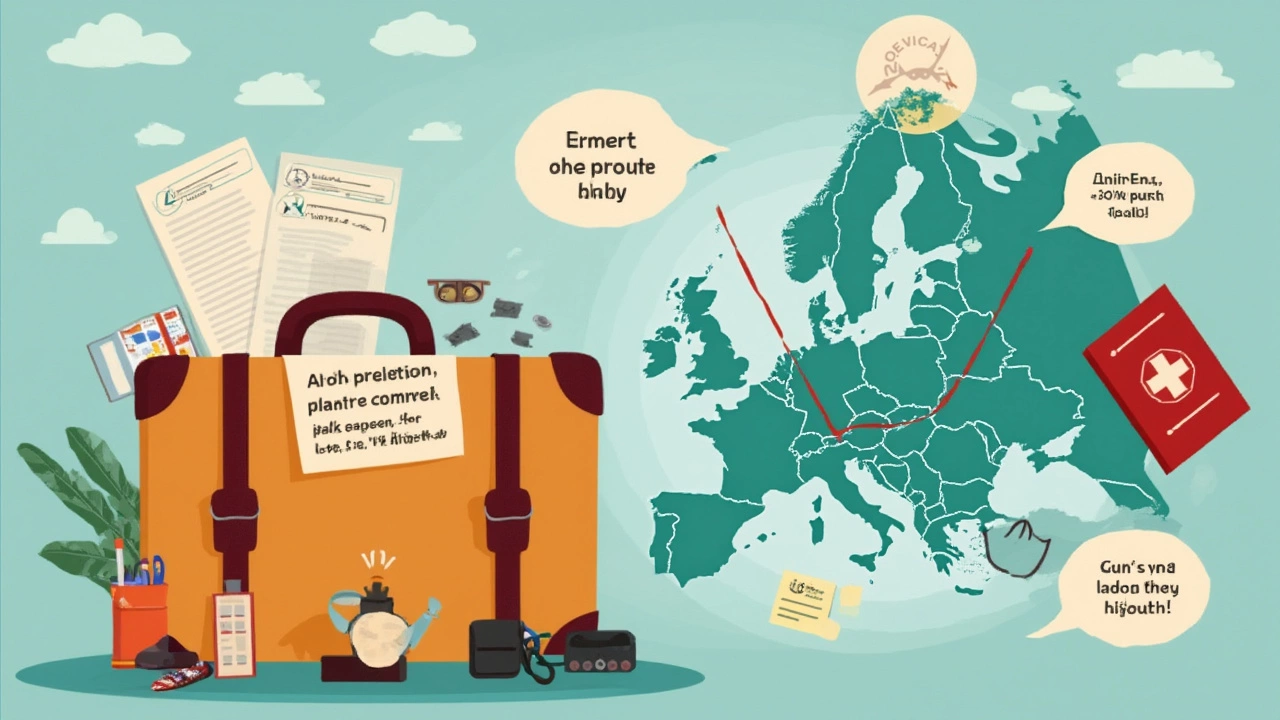
You’re on a trip in Paris. Suddenly, your 8-year-old needs stitches—what’s next? Most Americans freak out about getting sick or hurt in Europe, but honestly, navigating a European hospital isn’t as wild as people think. First off, don’t expect anyone to ask for proof of insurance at the door. The staff will treat you, paperwork comes after.
Europe's hospitals, especially in bigger cities, are used to dealing with tourists. English is spoken more often than not, especially at the front desk and in emergency rooms. Forget those horror stories about endless waiting; in most European countries, emergencies get seen quickly and with less fuss than most ERs in the States.
But don’t leave your passport at the hotel. You’ll need ID, plus they’ll probably ask where you’re staying. A credit card helps too—some places might request a deposit up front if you’re not a local. If you do have travel insurance, keep those details handy. They’ll want it before you check out so you’re not stuck paying the full bill yourself.
- Getting admitted: What actually happens
- Paperwork and language: What to expect
- How much will it cost—and why
- Insurance, consulates, and staying connected
- Types of care: Emergency vs. planned visits
- Smart tips for Americans in European hospitals
Getting admitted: What actually happens
If you’re an American hospital Europe patient, the process won’t feel like home, but it won’t be confusing either. Walk into any European emergency department and head straight to the reception or triage window. Don’t worry—nobody expects you to have a national health card. Tell them what happened and show your passport. They'll log your info and decide how serious it is. Priority goes to the sickest or most urgent cases, which means if you’ve got chest pain or a broken bone, you’ll be seen fast—even faster than many U.S. ERs.
Here’s how it usually goes down, step by step:
- Registration: Present your passport and give them your contact info. Some hospitals request details about where you’re staying in Europe—handy if they need to reach you later. If you have travel or health insurance, now’s the time to mention it (or show your card).
- Triage: A nurse will ask questions about your symptoms. In most large hospitals, they’ll speak enough English to understand basic complaints. They’ll check things like blood pressure, temperature, maybe a quick exam to rate urgency.
- Wait time: Unlike busy U.S. ERs, many European hospitals sort patients by urgency, not a first-come, first-served system. That can mean a shorter wait for real emergencies, sometimes even under 30 minutes in most urban hospitals.
- Admission or treatment: In true emergencies, you’ll go straight for treatment or get a bed. If it’s less urgent (like a sprained ankle), you might wait a bit. Still, people traveling with kids (trust me—been there with Vihaan) often get bumped up in line, especially in family-friendly countries like the Netherlands or Germany.
Here’s a cool stat: Over 80% of hospitals in Western Europe have a separate international desk or English-speaking support for medical tourism patients. Some even have someone who’ll walk you through forms and help translate if you freeze up with the language.
Just know, most places won’t ask for payment right away. They want you to get care first—dealing with admin comes later. If you need anything urgently, speak up. European staff don’t expect patients to wait silently, and you definitely won’t offend anyone by letting them know if your symptoms are getting worse.
Paperwork and language: What to expect
Here’s what actually happens with paperwork and language when you roll up to a hospital in Europe as an American. Don’t expect mile-long forms like at home. Most European hospitals will just ask for your passport or ID, some basic info about where you’re staying, and maybe your travel insurance details. You won’t need your entire medical history, but if you have allergies or a long-term condition, it helps to write that down clearly (ideally in English and the local language—Google Translate can be a lifesaver).
For emergencies, staff skip the paperwork until things are stable. In a less urgent situation, you might fill out a short form—name, birthday, home address, and emergency contact. Some countries (like Germany and France) might ask you to sign a consent form for treatment, but it’s usually one page and straightforward.
- Bring your passport every time.
- Travel insurance card or any proof of coverage is a big plus.
- Know your allergies/meds, ideally written down.
On the language front, big city hospitals almost always have someone who speaks English, even if it's just enough to get by in an emergency care situation. Smaller clinics or rural spots? Might be more hand gestures and translation apps. Nurses and doctors are used to tourists, and they won’t judge bad phrasing—they just want clear facts to avoid mistakes.
Some hospitals use translation services, sometimes by phone. For anything important—like describing pain levels or understanding medication—don’t be shy about repeating yourself, or asking the staff to write it down. Printouts or handouts about conditions or prescriptions are often available in English at tourist hotspots (think Barcelona, Rome, or Amsterdam).
If you want a quick look at how common English is in hospitals, check this:
| Country | English use in hospitals (urban) |
|---|---|
| Netherlands | Nearly all staff |
| France | Front desk & some doctors |
| Germany | Emergency staff & many younger docs |
| Italy | Most front desks, less common in rural areas |
| Spain | Major cities: frequent; rural: rare |
If you end up lost in translation, hand your phone to staff for a quick Google Translate session. It’s normal, and most staff are patient with language setbacks. Remember, what they care about most is treating you safely—not perfect grammar.
How much will it cost—and why
This is where most Americans get a shock. Hospital care in Europe is rarely anything close to what you’d pay back home. Let’s say you walk into an ER in Germany or France—an average visit for something minor (like stitches or an X-ray) can run under $200 if you’re paying out of pocket. Compare that to the U.S., where the bill might start at $1,200 just for walking in the door. There’s a reason people talk about medical tourism—the numbers really are that different.
Most European countries have public health systems which means the government negotiates prices, and there’s not a pile of extra “facility fees.” If you end up in Spain or Portugal, you could pay even less—sometimes under $100 for a doctor visit and medicine. Real talk: I saw a Belgian ER bill for a sprained ankle come in at $60, including crutches. The prices aren’t secret, either. At most hospitals, you can ask for a printed estimate if you’re worried.
If you need surgery or anything major, the cost will go up—but not like in the States. For example, a simple appendix surgery in France costs roughly $2,500 for a non-resident. In the U.S., that same surgery might slap you with a bill over $15,000.
| Service | Average Price (Europe, USD) | Average Price (U.S., USD) |
|---|---|---|
| ER Visit (minor) | $100-$200 | $1,000-$2,000 |
| Appendix Surgery | $2,500 | $15,000+ |
| 1 Night Hospital Stay | $250-$500 | $2,000-$4,000 |
Here’s why it’s cheaper:
- European hospitals don't pad bills with random administrative charges.
- Staff salaries and drug costs are usually lower due to government negotiations.
- Most countries prioritize affordable but good healthcare access, even for visitors.
If you've got travel insurance or an international health policy, you might not even see a bill at all—just fill out a claim and let your insurer handle it. That said, always get copies of your receipts and ask for an itemized bill. If you don’t have insurance, pay with a credit card and keep proof to file for reimbursement later. That’s how the pros avoid headaches after the trip.

Insurance, consulates, and staying connected
If you’re an American heading to the hospital in Europe, travel insurance can save you a tidal wave of stress. European hospitals won’t turn you away, but if you don’t have insurance, you’ll pay out of pocket—and while costs are often way lower than in the U.S., a broken arm in Switzerland or France can still run several hundred to a few thousand dollars, especially if you need overnight care or surgery.
Here’s the must-know stuff for handling insurance:
- Keep a digital and paper copy of your travel insurance policy. Your phone can run out of battery; paper doesn’t.
- Most American health plans (even fancy ones) don’t cover you abroad. Medicare never does. Unless your policy specifically says worldwide or includes "evacuation," assume you’re on your own.
- EU hospitals often ask for money up front, unless you have a clear, cashless agreement between your insurer and the hospital. Ask early if they have that option.
- Collect every receipt—doctor fees, prescriptions, ambulance rides. Your insurer will want proof before any reimbursement.
If you’re uninsured and stuck with a huge bill, the U.S. embassy can’t pay it for you. But the American consulate can point you to English-speaking doctors, help with paperwork, and contact family if things get rough. Their emergency lines work 24/7, and they won’t judge. I had a friend in Prague who lost his passport after a hospital visit, and the consulate bailed him out with paperwork so he could fly home.
Staying in touch is key if you’re admitted. Most major hospitals offer free WiFi, but smaller ones may not. You’ll want:
- Your phone charger (plug type depends on the country—UK and Ireland are different from France, Germany, or Spain).
- A list of emergency contacts saved as "ICE" (In Case of Emergency) in your contacts—European hospitals know what this is.
- Your insurance company’s 24-hour helpline number in your phone and written down. Some insurers require you to call them first for pre-approval or to avoid surprise bills later.
Here’s a look at what you might pay without insurance, just for perspective:
| Country | ER Visit (USD) | Appendectomy (USD) |
|---|---|---|
| France | $300-500 | $2,500-4,000 |
| Germany | $200-450 | $3,000-5,000 |
| Spain | $150-400 | $3,000-4,000 |
| Switzerland | $400-800 | $5,000-8,000 |
So, don’t take a gamble. Good travel insurance is way cheaper than a European hospital bill—plus, insurers help sort out paperwork and cash guarantees with the hospital, taking a ton off your plate when you just want to heal and go back to exploring.
Types of care: Emergency vs. planned visits
Here’s where things get real for any American thinking about hospital care in Europe. The way you’re treated—and how much you pay—depends on whether you roll up as an emergency or you’ve planned your visit ahead.
Emergency care is pretty straightforward. European countries see healthcare as a public service, not something only for those with insurance. If you break your arm in Rome or have an asthma attack in Berlin, you’ll be seen by a doctor, no questions asked. Actual life-or-death stuff? They handle that first, insurance or not. You’ll probably fill out forms only after you’re out of danger. In places like France or Spain, it’s not weird at all for tourists to walk out of ERs with bills much lower than what they’d pay back home—often a few hundred dollars instead of thousands.
If you’ve got a planned visit—like for a consultation, scheduled surgery, or a second opinion—things get a bit more complicated. Most hospitals will want your insurance and payment details up front. Here’s what you should have ready:
- Your passport and a backup ID
- Your travel insurance info (if any)
- Details about your medical history, written down (yes, in English is fine—staff can usually translate if needed)
- Any written communication or referral from your doctor back in the States
Keep this in mind: you’ll probably pay for non-emergency care upfront, especially in private clinics. Some places work directly with American travel insurance, but others might need you to pay first and claim your money back later.
| Type of Care | Common Cost (USD) | Paperwork Timing |
|---|---|---|
| Emergency Care (France) | 200-400 | After treatment |
| Planned Specialist Visit (Spain) | 100-250 | Before treatment |
| Major Surgery (Germany, Private) | 2,000-15,000 | Before/Deposit |
If you’re just visiting for a sprained ankle or fever, emergency services cover you without much hassle. But for something planned, like seeing a dermatologist or getting a checkup, you’ll need to do some paperwork first. This is where people trip up—they show up hoping to just pay by credit card, but staff will want more info and maybe even a referral or translation.
So, quick tip: for American hospital Europe adventures, emergencies are simpler to handle, but anything planned needs more homework. Always email or call ahead, and double-check the payment process. It can spare you a lot of stress—trust me, my wife learned this the hard way when she tried to book a routine appointment for Vihaan’s allergy testing in Amsterdam last July.
Smart tips for Americans in European hospitals
Don’t show up unprepared, or you’ll regret it. Here’s how to make a European hospital visit way less stressful, whether it’s an emergency or something less urgent. These tips work whether you’re in Italy’s countryside or a German city.
- Keep important documents handy: Always pack your passport, proof of travel insurance, and credit card in an easy-to-reach spot. Hospitals usually want your ID, and having insurance details ready can save you time and money.
- Phrases matter: Learn a few local words for “hospital,” “doctor,” “allergy,” and “emergency.” Google Translate or a screenshot helps if you’re totally lost with the language.
- Know how to call for help: The emergency number is 112 in pretty much all European countries. You don’t need to dial a country code—just those three numbers from any phone.
- Be ready to pay upfront: Without a European address, some hospitals might ask for a small deposit or payment before treatment. Costs can still be way lower than the U.S.—for example, an ER visit in France typically runs under $100.
- Don’t expect private rooms: Basic care in public hospitals is solid, but you may end up with roommates. If you want extras (like a private room or visiting specialist), that’s sometimes available but costs more.
- Keep your meds organized: Bring your prescriptions in their original bottles, and know the generic names. Some brands are different, and pharmacists can help you find a match if you need a refill.
Here’s a quick look at what you might pay for basic care compared to U.S. prices:
| Treatment | Europe (avg. EUR/USD) | U.S. (avg. USD) |
|---|---|---|
| ER Visit (non-emergency) | 50-120 EUR (~$54-$130) |
$500-$2,000 |
| Stitches for minor cut | 35-70 EUR (~$38-$76) |
$200-$800 |
| One day hospital stay | 300-700 EUR (~$325-$760) |
$2,000-$4,000 |
One last thing—if you hit a snag or feel things are getting lost in translation, call your embassy or consulate. They can help sort things out if language or red tape gets in the way. And if you have specific allergies, write them down in the local language before you travel. You don’t want confusion over something deadly.





Rohan Talvani
I am a manufacturing expert with over 15 years of experience in streamlining production processes and enhancing operational efficiency. My work often takes me into the technical nitty-gritty of production, but I have a keen interest in writing about medicine in India—an intersection of tradition and modern practices that captivates me. I strive to incorporate innovative approaches in everything I do, whether in my professional role or as an author. My passion for writing about health topics stems from a strong belief in knowledge sharing and its potential to bring about positive changes.
view all postsWrite a comment